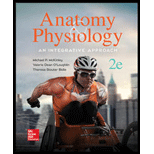
_____ 1. The cell body of a neuron does all of the following except
- a. release neurotransmitter into the synaptic cleft
- b. produce synaptic vesicles containing neurotransmitter that are subsequently transported to the synaptic knob.
- c. conduct graded potentials to the initial segment
- d. receive graded potentials from dendrites.
Introduction:
Neuron is a basic functional unit of the nervous system and is the specialized cells of the nervous system that makes a complex network for the transmission of messages. A neuron is made up of a cell body, nerve fibers: dendrites and an axon in its structure.
Answer to Problem 1DYKB
Correct answer:
The cell body of the neuron does not involve the released neurotransmitter into the synaptic cleft. Therefore, option a is correct.
Explanation of Solution
Reasons for the correct statements:
Option a. is given as “release neurotransmitter into the synaptic cleft”. Cell body does not involve in the production of neurotransmitter. The axon part of the cell body receives the graded potential which causes fusion of synaptic vesicle to the vesicle to the plasma membrane of the synaptic knob. This fusion results in the release of neurotransmitter from the synaptic vesicle. Hence, cell body does not cause the release of neurotransmitter into the synaptic cleft.
Hence, option a is correct.
Reasons for the incorrect statements:
Option b. is given as “produce synaptic vesicles containing neurotransmitter that is subsequently transported to the synaptic knob”. The cell body is involved in the synthesis of synaptic vesicles which contain neurotransmitter and these synaptic vesicles are ultimately transported to the synaptic knob through axon. Hence, option b. is incorrect.
Option c. is given as “conduct graded potentials to the initial segment”. The cell body involves the conduction of graded potential. Hence, option c. is incorrect.
Option d. is given as “receive graded potentials from dendrites”. The cell body receives the chemical potential from the dendrites. Hence, option d. is incorrect.
Hence, options b., c., and d. are incorrect.
The release of neurotransmitter into the synaptic cleft is not the function of the cell body.
Want to see more full solutions like this?
Chapter 12 Solutions
Anatomy & Physiology: An Integrative Approach
Additional Science Textbook Solutions
Biology: Life on Earth with Physiology (11th Edition)
Microbiology Fundamentals: A Clinical Approach
Human Physiology: An Integrated Approach (8th Edition)
Laboratory Manual For Human Anatomy & Physiology
- What are the roles of DNA and proteins inside of the cell? What are the building blocks or molecular components of the DNA and proteins? How are proteins produced within the cell? What connection is there between DNA, proteins, and the cell cycle? What is the relationship between DNA, proteins, and Cancer?arrow_forwardWhy cells go through various types of cell division and how eukaryotic cells control cell growth through the cell cycle control system?arrow_forwardplease make the drawing and steps of whats it asking. thank you!arrow_forward
- please fill in empty spots. thank you!arrow_forwardplease fill in the empty sports, thank you!arrow_forwardIn one paragraph show how atoms and they're structure are related to the structure of dna and proteins. Talk about what atoms are. what they're made of, why chemical bonding is important to DNA?arrow_forward
- What are the structure and properties of atoms and chemical bonds (especially how they relate to DNA and proteins).arrow_forwardThe Sentinel Cell: Nature’s Answer to Cancer?arrow_forwardMolecular Biology Question You are working to characterize a novel protein in mice. Analysis shows that high levels of the primary transcript that codes for this protein are found in tissue from the brain, muscle, liver, and pancreas. However, an antibody that recognizes the C-terminal portion of the protein indicates that the protein is present in brain, muscle, and liver, but not in the pancreas. What is the most likely explanation for this result?arrow_forward
- Molecular Biology Explain/discuss how “slow stop” and “quick/fast stop” mutants wereused to identify different protein involved in DNA replication in E. coli.arrow_forwardMolecular Biology Question A gene that codes for a protein was removed from a eukaryotic cell and inserted into a prokaryotic cell. Although the gene was successfully transcribed and translated, it produced a different protein than it produced in the eukaryotic cell. What is the most likely explanation?arrow_forwardMolecular Biology LIST three characteristics of origins of replicationarrow_forward
 Concepts of BiologyBiologyISBN:9781938168116Author:Samantha Fowler, Rebecca Roush, James WisePublisher:OpenStax College
Concepts of BiologyBiologyISBN:9781938168116Author:Samantha Fowler, Rebecca Roush, James WisePublisher:OpenStax College
 Biology 2eBiologyISBN:9781947172517Author:Matthew Douglas, Jung Choi, Mary Ann ClarkPublisher:OpenStax
Biology 2eBiologyISBN:9781947172517Author:Matthew Douglas, Jung Choi, Mary Ann ClarkPublisher:OpenStax Biology: The Dynamic Science (MindTap Course List)BiologyISBN:9781305389892Author:Peter J. Russell, Paul E. Hertz, Beverly McMillanPublisher:Cengage Learning
Biology: The Dynamic Science (MindTap Course List)BiologyISBN:9781305389892Author:Peter J. Russell, Paul E. Hertz, Beverly McMillanPublisher:Cengage Learning Human Physiology: From Cells to Systems (MindTap ...BiologyISBN:9781285866932Author:Lauralee SherwoodPublisher:Cengage Learning
Human Physiology: From Cells to Systems (MindTap ...BiologyISBN:9781285866932Author:Lauralee SherwoodPublisher:Cengage Learning Human Biology (MindTap Course List)BiologyISBN:9781305112100Author:Cecie Starr, Beverly McMillanPublisher:Cengage Learning
Human Biology (MindTap Course List)BiologyISBN:9781305112100Author:Cecie Starr, Beverly McMillanPublisher:Cengage Learning





